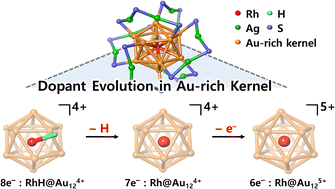Doping atomically precise metal nanoclusters (NCs) with heterometals is a powerful method for tuning the physicochemical properties of the original NCs at the atomic level. While the heterometals incorporated into metal NCs are limited to group 10–12 metals with closed d-shells, the doping of open d-shell metals remains largely unexplored. Herein, we report the synthesis of Rh-doped Au–Ag alloy NCs by a metal-exchange reaction of [RhHAg24(SPhMe2)18]2− NCs with an Au–thiolate complex. Combined experimental and theoretical structural studies revealed that the synthesized product is a dianionic [RhHAuxAg24−x(SPhMe2)18]2− NC (x = 8–12), consisting of RhH dopant, Au-rich kernel, and Ag-thiolate staple motifs, with the superatomic 8-electron configuration (1S21P6). Under aerobic conditions, the synthesized NCs underwent kernel evolution to generate a 6-electron [RhAuxAg24−x(SPhMe2)18]1− NC (1S21P4), which was initiated by the desorption of hydride from the kernel. Structural analysis of the [RhHAuxAg24−x(SPhMe2)18]2− NC suggests that the kernel evolution is induced by the change in chemical bonds surrounding the hydride in the Au-rich kernel.
